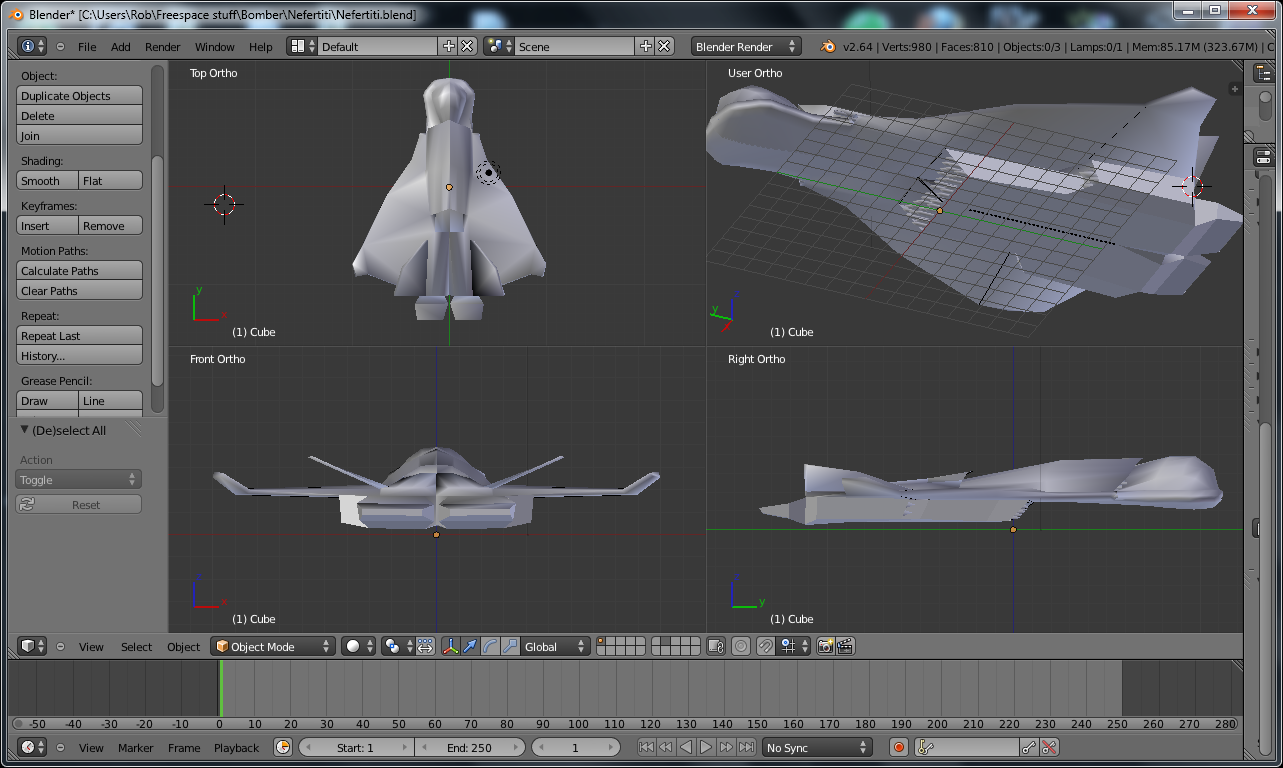During the latter half of the 20th century, stealth Aircraft were developed in the Unites States of America. 1978 saw the first flight of what would be called the F-117A Nighthawk. The first stealth fighter. Soon after came the B2 Spirit from Northrop Grumman. These craft along with the F-22 Raptor and others were to be the cutting edge of Low Observable Craft (LOC’s).
Supremecy in the air would depend on stealth until 2038, when the networking of ULF and Forward Scattering radars along with spaceborn systems began a golden age of detection. Stealth aircraft were no longer invisible. Both Lockheed and Northrop Grumman would fall off into obscurity as they worked on more conventional aircraft.
2086 saw the merger of these two military hardware competitors. The LNG Corporation, as fate would have it would begin to play a role in the future of mankind. As man took to the stars, LNG would develop new technologies for the exploration of space, and when the First Multiworld War began on 14 June 2117, technologies developed by LNG would lead to the first single pilot fighter for space use.
The SF-1X was designed and built solely for operations in space. The first combat mission for the Starfighter was the defense of Noah. Stationed in a geosyncronous orbit of above Mars, the station itself was originally a logistics center for the colonization of Mars.
James Britton of the Mars division of LNG ordered the creation of the Starfighter. The viability test was simply placing a spread focus mining laser onto a shuttle. The tests led to the creation of the SF-1X Starfighter. Slow to manouver, it performed in all tests admirably. It was put to the test on 11 May 2118.
Early launch warnings sounded and a flight of four Starfighters were dispatched against a full dozen incoming missiles. The Starfighters responded in what would seem to be a slow and cumbersome state, but which were in fact manouvering at very high speeds. The speed itself was to be the factor which almost lost the day. Too high was the speed, and too great was the turn radius, as it was believed that a Z rotation was not feasible for a fighter. In the end, 1 missile did slip past the fighters without being destroyed, but this was intercepted by the Phalanx anti missile system aboard the station. In all, the four Starfighters counted for 11 enemy missiles down, with no losses.
Soon, LNG Earth division would also begin to field a starfighter of its own, the Dolphin. Though the Dolphin and the Starfighter would never meet in open combat, the two would usher in the age of the Space fighter. They would also herald the schizm that tore LNG apart.
For two and a half centuries, LNG would be only a memory, as the two corporations spawned from it would compete against one another for lucrative military contracts. No longer developing fighters, but instead focussing on weapons systems and sensors. No longer using Radar alone, most spacefaring vessels use a combination of sensors involving Radar, Magnetic anomoly detection, IR detection, and EM detection.
The advent of the Pegasus stealth fighter led to talks between Seaonus and The Coherent Light Company. This eventually led to a merger between the two companies, and the recreation of Lockheed Northrop Grumman.
The first order of business for LNG was to reclaim the stealth throne. Using the latest advances in sensors and radars, they started small, with the LM-02, a high explosive dead fire missile developed for military use. A reduction in solid fuel capacity would shorten the range considerably, but would then add an aspect seeking guidance system. Advanced composites would render it radar invisible, and ceramics and IR supression would hide it from magnetic anomoly and IR detection. This learning experience would be shelved for nearly a decade.
While expanding the horizon of stealth technology into the Pharaoh stealth superiority fighter, Chairman Edward Nakamura would set the parameters for the next generation stealth fighter. LNG would later use the lessons of both the LM-02 and the Pharaoh to develop a platform for the LM-02. The result would be a true stealth bomber named Nefertiti.
The Nefertiti would use the same composites and ceramics as the LM-02 and Pharaoh, but aproach speeds nearly equal to an average assault fighter. Her advanced shell gives her an edge, albeit slight, in armor, and her shields will offer some degree of protection. The only drawbacks of this craft are the shields, which for EM detection reasons are minimal to moderate at best, and her manouverability. While easily able to match that of her target or of a heavy bomber, her IR supression does play a role in the lack of power to manouvering thrusters. Taking the Nefertiti against fighters is something that should be avoided if at all possible.
With the drastically reduced range of the LM-02, now called Cardinal, it was widely known that it would never be carried by conventional bombers. The role of the Nefertiti would be simple. Get in close using her excellent speed and stealth, launch her LM-02 Cardinals at turrets, and escape. The heavy bombing would be done by conventional bombers who then would need not worry about enemy fire from the target.
Both the Pharaoh and the Nefertiti would see first deployment with Special Operations Command in Adhara, 8 months after contract signing.


